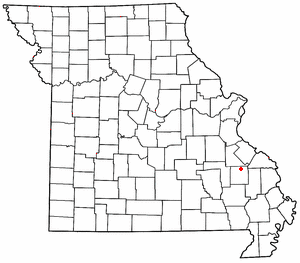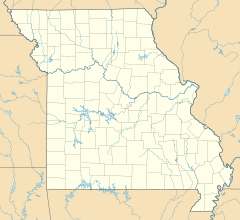
Sainte Genevieve County, often abbreviated Ste. Genevieve County, is a county located in the eastern portion of the U.S. state of Missouri. As of the 2010 census, the population was 18,145. The largest city and county seat is Ste. Genevieve. The county was officially organized on October 1, 1812, and is named after the Spanish district once located in the region, after Saint Genevieve, patroness of Paris, France. It includes the earliest settlement west of the Mississippi River outside New Spain, part of the French colonial mid-Mississippi valley villages. It is one of the last places where the Paw Paw French is still spoken.

Perry County is a county located in the southeastern portion of the U.S. state of Missouri. As of the 2010 census, the population was 18,971. Its county seat is Perryville. The county was officially organized on November 16, 1820 from Ste. Genevieve County and was named after Oliver Hazard Perry, a naval hero of the War of 1812.

Mine La Motte is an unincorporated community and census-designated place in Madison County, Missouri, United States. It is located approximately six miles north of Fredericktown. Europeans discovered lead here and had also hoped to find silver. The French Governor of Louisiana, Antoine de la Mothe Cadillac, failed to find silver, but succeeded in recruiting investors in The Company of the West, which was organized in 1717. Mine La Motte was eventually settled by about 200 French settlers along with their slaves from Santo Domingo, under the leadership of Philip François Renault, to develop mines in 1717, making it one of the oldest settlements west of the Mississippi River. The presence of lead, a critical ingredient for ammunition, attracted unusually early mining by French colonists in this otherwise remote interior region of the North American continent. That same lead, still used for ammunition at the time of the American Civil War, was also a factor in the Battle of Fredericktown in which forces aligned with the Confederate States of America fought for control of the lead smelters in nearby Fredericktown with the Unionist forces, aligned with the United States of America.

River aux Vases is an unincorporated community in Beauvais Township in Sainte Genevieve County, Missouri, United States.

Cinque Hommes is one of the eight townships located in Perry County, Missouri, in the United States of America.

Bois Brûlé is one of the eight townships located in Perry County, Missouri, in the United States of America.

Union is one of the eight townships located in Perry County, Missouri, in the United States of America.

The Bois Brule Bottom is an alluvial floodplain in Bois Brule Township in Perry County, Missouri stretching between Bois Brule Creek to the west and the Mississippi River to the east.

New Bourbon is an abandoned village located in Ste. Genevieve Township in Ste. Genevieve County, Missouri, United States. New Bourbon is located approximately two and one-half miles south of Ste. Genevieve.
La Saline is an abandoned village located in Beauvais Township in Sainte Genevieve County, Missouri, United States. La Saline was located approximately six miles south of Sainte Genevieve.

Central Township is one of the eight townships located in Perry County, Missouri, United States.

Saline Township is one of the eight townships located in Perry County, Missouri, in the United States of America.

Le Grand Champ is is an alluvial floodplain, also called a bottom, extending along the Mississippi River in Ste. Genevieve County, Missouri.

Cinque Hommes Creek is a tributary of the Mississippi River flowing through Perry County, Missouri.

Apple Creek is a stream that rises in western Perry County, Missouri and empties into the Mississippi River, forming the boundary between Perry and Cape Girardeau counties.

Beauvais Township is a subdivision of Ste. Genevieve County, Missouri, in the United States of America, and is one of the five townships located in Ste. Genevieve County.

River aux Vases is a creek that rises in Union Township in western Ste. Genevieve County, Missouri and flows into the Mississippi River about two miles north of St. Marys, Missouri.

Saline Township is a subdivision of Ste. Genevieve County, Missouri, in the United States of America, and is one of the five townships located in Ste. Genevieve County.

Ste. Genevieve Township is a subdivision of Ste. Genevieve County, Missouri, in the United States of America, and is one of the five townships located in Ste. Genevieve County.



















